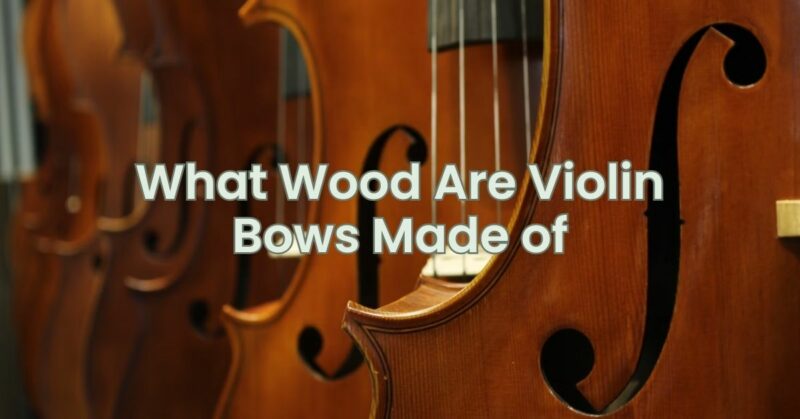The construction of a violin bow involves careful consideration of the wood used, as it significantly impacts the bow’s performance, responsiveness, and overall quality. Various types of wood have been historically used for making violin bows, each with its unique characteristics. In this article, we will explore the primary woods used in the construction of violin bows and delve into their properties and contributions to the bow’s playability and sound production.
- Pernambuco Wood (Caesalpinia echinata): Pernambuco wood is the most prized and sought-after material for crafting high-quality violin bows. It comes from the Pau-Brasil tree and is primarily sourced from Brazil. Pernambuco wood offers exceptional qualities that contribute to the performance of a bow, including:
- Strength and Flexibility: Pernambuco wood is known for its strength, resilience, and flexibility. These characteristics allow for controlled and nuanced bowing techniques, facilitating expressive playing.
- Warmth and Tonality: Pernambuco bows are renowned for producing warm, rich tones. The wood’s natural properties contribute to the depth, complexity, and tonal richness of the sound produced.
- Responsiveness: Pernambuco wood has a unique responsiveness, allowing for dynamic control and sensitivity to subtle nuances in a player’s technique.
- Brazilwood (Caesalpinia spp.): Brazilwood is another type of wood used in the construction of violin bows, particularly in student or intermediate-level bows. While it is not as highly regarded as pernambuco wood, it still offers several favorable qualities:
- Flexibility: Brazilwood possesses a degree of flexibility that allows for controlled and responsive bowing. It provides a good balance between stiffness and flexibility, making it suitable for players developing their technique.
- Affordability: Brazilwood bows are generally more affordable compared to pernambuco bows. They offer a cost-effective option for beginners or those on a limited budget.
- Sound Projection: While not as tonally rich as pernambuco, Brazilwood bows can produce a satisfactory sound projection, making them suitable for student-level playing.
- Snakewood (Piratinera guianensis): Snakewood is a rare and visually distinctive wood used in the construction of violin bows. It derives its name from its distinct snake-like grain pattern. Snakewood bows are highly prized for their unique characteristics:
- Density and Hardness: Snakewood is one of the densest and hardest woods used for violin bows. Its hardness contributes to the bow’s stability and longevity.
- Responsiveness and Articulation: Snakewood bows offer excellent responsiveness and articulation, allowing for precise and controlled bowing techniques. They are particularly favored for their clarity and ability to articulate fast passages.
- Other Woods: In addition to the aforementioned woods, other types of wood may be used for violin bows, albeit less commonly. These woods include ebony, ironwood, and various types of tropical hardwoods. Each wood type brings its unique properties and can influence the bow’s playability and sound.
Conclusion: The wood used in the construction of a violin bow plays a crucial role in its performance, responsiveness, and tonal characteristics. Pernambuco wood stands as the most esteemed material, renowned for its strength, flexibility, warmth, and tonal richness. Brazilwood offers a more affordable alternative, suitable for student or intermediate-level bows. Snakewood, with its unique grain pattern, provides excellent responsiveness and articulation. Other woods may also be used, contributing to the diverse range of bows available.
When selecting a violin bow, understanding the properties and qualities of the wood used is essential. However, it is equally important to consider personal preferences, playing style, and budget. Trying out different bows and seeking guidance from experienced violinists or knowledgeable professionals will help you find a bow that matches your individual needs and enhances your musical expression.

